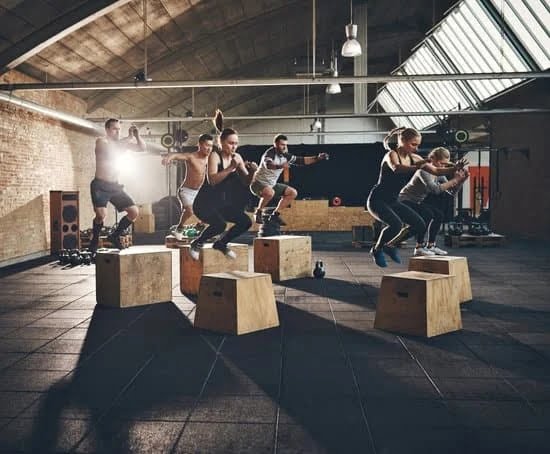Basketball is an intense and physically demanding sport that requires athletes to possess a high level of fitness in order to excel on the court. For basketball players, having a comprehensive fitness routine is essential for enhancing performance, preventing injuries, and achieving success in the game.
In this article, we will explore the key components of a fitness routine for basketball players, including warm-up exercises, strength training, agility drills, conditioning, flexibility work, rest and recovery techniques, and proper nutrition. By understanding the importance of fitness in basketball and implementing a well-rounded routine, players can elevate their game to the next level.
To excel in basketball, players need to focus on improving their strength, speed, agility, endurance, and flexibility. A well-designed fitness routine tailored specifically for basketball can help athletes develop these crucial physical attributes while also reducing the risk of injury on the court. Whether you’re a beginner looking to enhance your skills or a seasoned player seeking to take your performance to new heights, incorporating these fitness components into your training regimen is vital for success.
In the following sections of this article, we will delve into each aspect of an effective fitness routine for basketball players. From dynamic stretching and cardiovascular exercises to targeted strength training and agility drills, we will provide valuable insights on how players can optimize their physical conditioning for peak performance during games.
Additionally, we will discuss the importance of rest days and proper recovery techniques as well as how nutrition plays a crucial role in fueling the body for optimal performance on the basketball court. Let’s dive into this comprehensive guide to understanding and implementing a fitness routine specifically designed for basketball players.
Warm-Up
When it comes to creating a fitness routine for basketball players, the warm-up phase plays a crucial role in preparing the body for the physical demands of the game. Dynamic stretching and cardiovascular exercises are essential components of a thorough warm-up routine for basketball players. These activities help improve flexibility, increase heart rate, and enhance blood flow to the muscles, thereby reducing the risk of injury during intense play on the court.
Dynamic Stretching Exercises
- Leg swings
- Arm circles
- High knees
- Lunges with a twist
Dynamic stretching involves moving parts of your body through a full range of motion to stretch and warm up your muscles. It is an effective way to prepare the body for physical activity and improve overall performance on the basketball court.
Cardiovascular Exercises
- Jump rope
- Running or jogging
- High-intensity interval training (HIIT)
Cardiovascular exercises such as jump rope, running, or HIIT help elevate the heart rate and increase circulation, allowing for improved oxygen delivery to working muscles. These exercises also help basketball players build endurance and stamina necessary for playing at a high intensity throughout a game.
Incorporating dynamic stretching and cardiovascular exercises into the warm-up routine not only prepares basketball players physically but also mentally for the demands of the game. It sets a solid foundation for the rest of their fitness routine, ensuring that they are primed for optimal performance on the court.
Strength Training
When it comes to strength training for basketball players, it is essential to target specific muscle groups that are crucial for the physical demands of the sport. Here are some key muscle groups to focus on when creating a strength training regimen for basketball players:
1. Legs: Strong and powerful legs are crucial for jumping, sprinting, and changing direction quickly on the basketball court. Incorporate exercises such as squats, lunges, calf raises, and leg presses to build lower body strength.
2. Core: A strong core is essential for stability, balance, and overall athleticism in basketball. Include exercises like planks, Russian twists, medicine ball throws, and bicycle crunches to strengthen the core muscles.
3. Upper Body: While lower body strength is important in basketball, it’s also crucial to have a strong upper body for shooting, passing, and defending. Incorporate exercises such as push-ups, pull-ups, shoulder presses, and chest flies to build upper body strength.
In addition to targeting these key muscle groups, it’s important to focus on functional movements that mimic the actions performed on the basketball court. This can help improve overall performance and reduce the risk of injury during games.
By incorporating targeted strength training exercises into their fitness routine for basketball players, athletes can improve their power, explosiveness, and physical durability on the court.
Agility and Speed Drills
To excel on the basketball court, players need to have sharp agility and quick reflexes. Agility training involves a series of drills designed to improve an athlete’s ability to change direction, accelerate, and decelerate quickly. Cone drills, ladder drills, and shuttle runs are great exercises for improving agility. These drills help basketball players enhance their footwork, coordination, and overall maneuverability during games.
In basketball, speed is a crucial factor that allows players to move swiftly up and down the court. Speed training focuses on developing acceleration and top-end speed. Sprints, interval running, and resistance training with tools like parachutes or sleds can help basketball players increase their speed. By incorporating these speed training exercises into their fitness routine, players can elevate their performance by being quicker on both offense and defense.
Reacting quickly to plays unfolding on the court is an essential skill for basketball players. Reaction time training involves drills that challenge an athlete’s ability to respond promptly to visual or auditory cues. Incorporating reaction ball drills, mirror drills, and decision-making exercises into a fitness routine can enhance a player’s ability to make split-second decisions during fast-paced game situations.
By including these agility and speed drills in their fitness routine for basketball players, athletes can greatly improve their quickness and reaction time on the court. Developing these physical attributes not only enhances individual performance but also contributes to the overall success of the team during games.
Conditioning
One key aspect of conditioning for basketball players is cardiovascular endurance. Running, sprinting, and other forms of aerobic exercise help improve a player’s ability to sustain high-intensity activity for longer periods. In addition to traditional cardiovascular exercises, incorporating drills that mimic the stop-and-go nature of basketball can be especially beneficial. This includes shuttle runs, suicide sprints, and interval training.
Another crucial component of conditioning for basketball players is muscular endurance. Basketball is a physically demanding sport that requires players to exert force repeatedly over the course of a game. Therefore, strength training exercises targeting the muscles used in basketball-specific movements are vital. Incorporating exercises such as squats, lunges, calf raises, and core strengthening routines can help improve muscular endurance and reduce the risk of injury on the court.
Lastly, it’s important for basketball players to incorporate sport-specific conditioning drills into their fitness routine. This can include practicing dribbling and shooting while fatigued, running defensive drills, and simulating game situations during workouts. By incorporating these elements into their fitness routines, basketball players can ensure that they are well-prepared for the physical demands of the game.
| Aspect of Conditioning | Recommended Exercises |
|---|---|
| Cardiovascular Endurance | Running, sprinting, shuttle runs, suicide sprints |
| Muscular Endurance | Squats, lunges, calf raises, core strengthening exercises |
| Sport-Specific Conditioning Drills | Dribbling and shooting while fatigued, running defensive drills |
Flexibility
The Importance of Flexibility
Basketball requires a wide range of motion, from jumping and reaching for rebounds to quickly changing direction on the court. Without proper flexibility, players may be more prone to muscle tightness and imbalances, which can increase the likelihood of injuries. Flexibility exercises help maintain optimal joint function and muscle elasticity, allowing athletes to move more freely and efficiently.
Flexibility Exercises for Basketball Players
To improve flexibility, basketball players should incorporate a variety of stretching techniques into their fitness routine. This may include dynamic stretching before practice or games to warm up the muscles and prepare them for movement, as well as static stretching after workouts to lengthen and release tension in specific muscle groups. Additionally, activities such as yoga or Pilates can help enhance overall flexibility and promote better body control on the basketball court.
Benefits of Flexibility Training
In addition to injury prevention, increased flexibility can also contribute to better performance on the basketball court. With improved range of motion, players can execute moves with greater ease and precision. This can result in faster reaction times, improved agility, and ultimately a competitive edge over opponents during gameplay. By prioritizing flexibility as part of their fitness routine, basketball players can enhance their physical abilities while reducing the risk of potential injuries that may hinder their performance.
Rest and Recovery
In addition to taking rest days, basketball players must also incorporate proper recovery techniques into their fitness routine. This includes activities such as stretching, foam rolling, massage therapy, ice baths, and adequate sleep. These methods help reduce muscle soreness, improve flexibility, increase blood flow, and promote overall relaxation for the body.
It’s important for coaches and trainers to educate players on the significance of rest and recovery in order to optimize their performance on the court. By implementing a well-rounded approach that includes both physical rest and effective recovery practices, basketball players can maintain peak condition throughout the season.
| Rest Days | Proper Recovery Techniques |
|---|---|
| Allow muscles to repair and rebuild | Incorporate stretching, foam rolling |
| Prevent injuries and burnout | Massage therapy |
| Improve athletic performance | Adequate sleep |
Nutrition
Having a proper nutrition plan is essential for basketball players looking to maximize their performance on the court. A well-balanced diet not only provides the necessary energy and nutrients for optimal physical exertion during games and workouts, but also plays a significant role in injury prevention and overall health. Proper nutrition can enhance endurance, strength, recovery, and mental focus, all of which are crucial for basketball players.
First and foremost, it’s important for basketball players to consume a sufficient amount of carbohydrates. Carbs are the body’s primary source of energy, especially during high-intensity physical activities like basketball. Complex carbohydrates such as whole grains, fruits, and vegetables provide a steady release of energy, helping to sustain performance throughout a game or practice session.
In addition to carbohydrates, protein is also vital for basketball players. Protein aids in muscle repair and growth, making it crucial for recovery after intense workouts or games. Lean sources of protein such as chicken, fish, beans, and low-fat dairy products should be included in the diet to support muscle development and repair.
Adequate hydration is equally important; staying properly hydrated is key to maintaining peak performance on the court. Basketball players should aim to drink plenty of water throughout the day to replace fluids lost through sweating during training and games.
By integrating these nutritional guidelines into their daily routine, basketball players can optimize their physical conditioning and be better prepared for the demands of intense gameplay. A well-rounded nutrition plan complements other aspects of fitness training and contributes to overall athletic success on the basketball court.
Conclusion
In conclusion, a comprehensive fitness routine is essential for basketball players to improve their performance on the court. By incorporating dynamic stretching, cardiovascular exercises, strength training, agility drills, conditioning, flexibility work, rest and recovery techniques, and proper nutrition, players can enhance their skills and avoid injuries. It is important to understand that a well-rounded fitness routine not only improves physical abilities but also contributes to mental toughness and overall well-being.
By focusing on targeted muscle groups with strength training and enhancing quickness with agility drills, basketball players can increase their power and speed during games. Moreover, endurance and stamina building exercises will help them last longer on the court without succumbing to fatigue. Proper rest days and recovery techniques are equally important for allowing the body to repair and rejuvenate for optimal performance.
Incorporating a balanced diet with the correct nutrients will ensure that basketball players have the energy they need to perform at their best. Overall, implementing a comprehensive fitness routine specifically tailored for basketball players will undoubtedly contribute to their success on the court. Stay disciplined and dedicated to your fitness regimen in order to achieve your full potential as an athlete.
Frequently Asked Questions
How Do You Build Fitness for Basketball?
Building fitness for basketball involves a combination of cardiovascular conditioning, strength training, and skill drills. Cardio exercises like running, jumping rope, and agility drills help improve endurance. Strength training focusing on legs, core, and upper body is crucial to handle the physical demands of the game.
How Can I Improve My Physical Fitness for Basketball?
Improving physical fitness for basketball begins with a well-rounded training program that includes cardio, strength training, flexibility work, and skill development. Incorporating exercises like sprints, plyometrics, weightlifting, and stretching will enhance overall athleticism and performance on the court.
How Many Days a Week Should a Basketball Player Workout?
A basketball player should aim to workout at least 4-6 days a week to maintain peak physical condition throughout the season. This routine allows for adequate time for rest and recovery while still providing enough opportunities for skill development, strength training, and conditioning workouts.
Properly spaced rest days are also important to prevent overtraining and reduce the risk of injury.

Passionate about providing useful information to anyone with an interest in the field of Personal Training, I strive to pass on to our readers quality information and to answer any questions about Personal Trainers, the work they do and how to become one.





